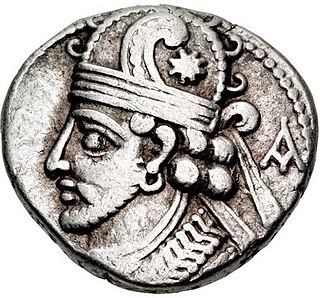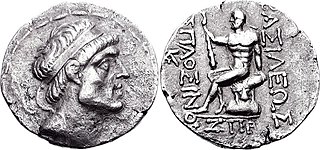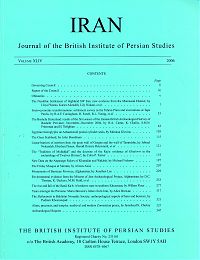
Mithridates I, also known as Mithridates I the Great, was king of the Parthian Empire from 165 BC to 132 BC. During his reign, Parthia was transformed from a small kingdom into a major political power in the Ancient East as a result of his conquests. He first conquered Aria, Margiana and western Bactria from the Greco-Bactrians sometime in 163–155 BC, and then waged war with the Seleucid Empire, conquering Media and Atropatene in 148/7 BC. In 141 BC, he conquered Babylonia and held an official investiture ceremony in Seleucia. The kingdoms of Elymais and Characene shortly afterwards became Parthian vassals. In c. 140 BC, while Mithridates was fighting the nomadic Saka in the east, the Seleucid king Demetrius II Nicator attempted to regain the lost territories; initially successful, he was defeated and captured in 138 BC, and shortly afterwards sent to one of Mithridates I's palaces in Hyrcania. Mithridates I then punished Elymais for aiding Demetrius, and made Persis a Parthian vassal.

Vologases I was the King of Kings of the Parthian Empire from 51 to 78. He was the son and successor of Vonones II. He was succeeded by his younger son Pacorus II, who continued his policies.

Sinatruces was king of the Parthian Empire from c. 75 BC to c. 69 BC. He was presumably a son of the Parthian ruler Mithridates I. Sinatruces was succeeded by his son Phraates III.

Artabanus I, incorrectly known in older scholarship as Artabanus II, was king of the Parthian Empire, ruling briefly from c. 127 to 124/3 BC. His short reign ended abruptly when he died during a battle against the Yuezhi in the east. He was succeeded by his son Mithridates II.

Artabanus II, incorrectly known in older scholarship as Artabanus III, was King of Kings of the Parthian Empire from 12 to 38/41 AD, with a one-year interruption. He was the nephew and successor of Vonones I. His father was a Dahae prince, whilst his mother was a daughter of the Parthian King of Kings Phraates IV

Pacorus II was the King of Kings of the Parthian Empire from 78 to 110. He was the son and successor of Vologases I.

Characene, also known as Mesene (Μεσσήνη) or Meshan, was a kingdom founded by the Iranian Hyspaosines located at the head of the Persian Gulf mostly within modern day Iraq. Its capital, Charax Spasinou, was an important port for trade between Mesopotamia and India, and also provided port facilities for the city of Susa further up the Karun River. The kingdom was frequently a vassal of the Parthian Empire. Characene was mainly populated by Arabs, who spoke Aramaic as their cultural language. All rulers of the principality had Iranian names. Members of the Arsacid dynasty also ruled the state.
The Battle of Ecbatana was fought in 129 BC between the Seleucids led by Antiochus VII Sidetes and the Parthians led by Phraates II, and marked the final attempt on the part of the Seleucids to regain their power in the east against the Parthians. After their defeat, the territory of the Seleucids was limited to the area of Syria.

Clifford Edmund Bosworth FBA was an English historian and Orientalist, specialising in Arabic and Iranian studies.

Andragoras was an Iranian satrap of the Seleucid provinces of Parthia and Hyrcania under the Seleucid rulers Antiochus I Soter and Antiochus II Theos. He later revolted against his overlords, ruling independently from 245 BC till his death.
Bamshad or Bāmšād was a musician of Sasanian music during the reign of Khosrow II.
Iran Shenasi also spelled as "Iranshinasi" is an academic journal of Iranian studies. The founding editor-in-chief is Jalal Matini. The journal is published in Persian and covers Iranian history, Persian culture, and Persian literature. The majority of research libraries in the world that have a Middle Eastern or Iranian studies program are subscribers and it is considered one of the most authoritative journals on the culture of Iran and Persian literature.

Hyspaosines was an Iranian prince, and the founder of Characene, a kingdom situated in southern Mesopotamia. He was originally a Seleucid satrap installed by king Antiochus IV Epiphanes, but declared independence in 141 BC after the collapse and subsequent transfer of Seleucid authority in Iran and Babylonia to the Parthians. Hyspaosines briefly occupied the Parthian city of Babylon in 127 BC, where he is recorded in records as king (šarru). In 124 BC, however, he was forced to acknowledge Parthian suzerainty. He died in the same year, and was succeeded by his juvenile son Apodakos.
Vesta Sarkhosh Curtis is the British Museum's Curator of Middle Eastern coins. She is Joint Director of the International Parthian Coin Project, The Sylloge Nummorum Parthicorum (SNP), and Joint Editor of the SNP series.

The Kings of Persis, also known as the Darayanids, were a series of Persian kings, who ruled the region of Persis in southwestern Iran, from the 2nd century BCE to 224 CE. They ruled as sub-kings of the Parthian Empire, until they toppled them and established the Sasanian Empire. They effectively formed some Persian dynastic continuity between the Achaemenid Empire and the Sasanian Empire.

Ardakhshir I was a dynast (frataraka) of Persis in the late 3rd-century BC, ruling sometime after 220 to c. 205 BC.
Sagdodonacus was an Iranian officer, who served as the governor of Characene from c. 184 BC to 164 BC under suzerainty of the Frataraka rulers of Persis. He was the father of Hyspaosines.

Darayan I was the first king of Persis, most likely invested with kingship of the region by his overlord, the Parthian monarch Phraates II sometime after 132 BC.

Ardakhshir II was king of Persis in the 1st century BC, a vassal state of the Parthian Empire. An inscription written in Middle Persian on a silver cup bears his name. He was succeeded by Wahsir.

Parthian coinage was produced within the domains of the Parthian Empire. The coins struck by the Parthians were mainly made of silver, with the main currencies being the drachm and tetradrachm. The tetradrachm, which generally weighed around 16 g, was only minted in Seleucia, first conquered by the Parthians in 141 BC. Design-wise, Parthian coinage was based on Seleucid and Achaemenid satrapal coinage.















